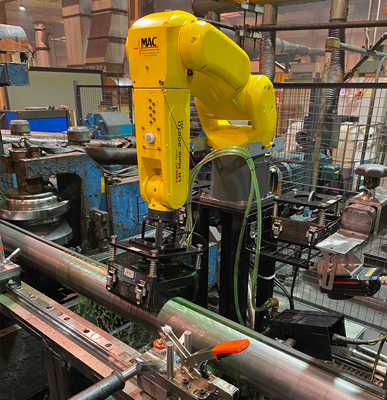
Inspecting Welded Tube
Accurate inspection systems are a key part of ensuring successful tube welding operations. Undercuts, under filled, incomplete penetration, spatter, overlap, and incomplete fusion, are just some of the conditions in the welding process that can cause tubing to fail. An accurate, timely Inspection, for example, installed within the heat affected zone, often within 40 feet of the welder at temperatures up to 252⁰ F (122⁰ C), prior to the forming rolls, can give the operator instant feedback when the scarfing tool is bad or broken. By providing test data immediately, adjustments to the welding operation can be made quickly, saving many feet of would be-scrap tube.
Phased Array Ultrasonic test systems such as MAC’s (Magnetic Analysis Corp.’s) latest Phased Array robotic system, Echomac® PA TW, can provide important advantages when inspecting for tube and pipe weld zone defects in the heat affected zone. This system can scan and test the entire weld area, without the need to move or change the settings. In the welding process the weld area is not always tightly controlled with respect to its position on the circumferential axis. Phased array scanning can handle this variation, inspecting several inches to ensure a smooth OD and ID free of weld flash and evaluate laminar defects in the heat affected zone. Additionally, by varying the pulse timing of the individual ultrasonic elements, the weld zone can be inspected with preprogrammed multiple angles if needed, all without any manual intervention.
MAC’s robotic system monitors the scarf, evaluates laminar defects, and detects longitudinal OD/ID defects typical of the weld process such as lack of fusion, pin hole penetrators, hook cracks, and misalignment of the parent material. B-scan and C-scan views result in real time images of the weld profile and defects, and no averaging or AGC is used. Intuitive HMI push buttons control the Robot and manipulate the test head. Integrated signals from the mill PLC initiate a quick retract to safety position when an approaching open weld, cut-out or similar condition occurs.
Installation can also be in a lower temperature production area below 140⁰ F (60⁰ C) for ID/OD longitudinal flaw detection and profile monitoring, after the forming and shaping operation. While the tube configuration in the hot zone area after the welder is not a uniform cylindrical shape, by the time it reaches further down line, the round shape and wall thickness is much more uniform enabling more accurate defect detection. The robot’s small footprint allows the customer to select the exact part of the process to be monitored ensuring the highest possible yield of production pipes. This phased array robotic system can handle tube and bar as small as 2.375“ (60.3mm) diameter with a minimum wall thickness of 0.120 mm., and pipe as large as 28” (711 mm) diameter.
Magnetic Analysis Corp. provides a range of nondestructive test instruments and systems for detecting weld zone defects, including gantry type test head positioning, conventional ultrasonic, and eddy current technologies.
